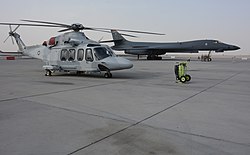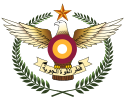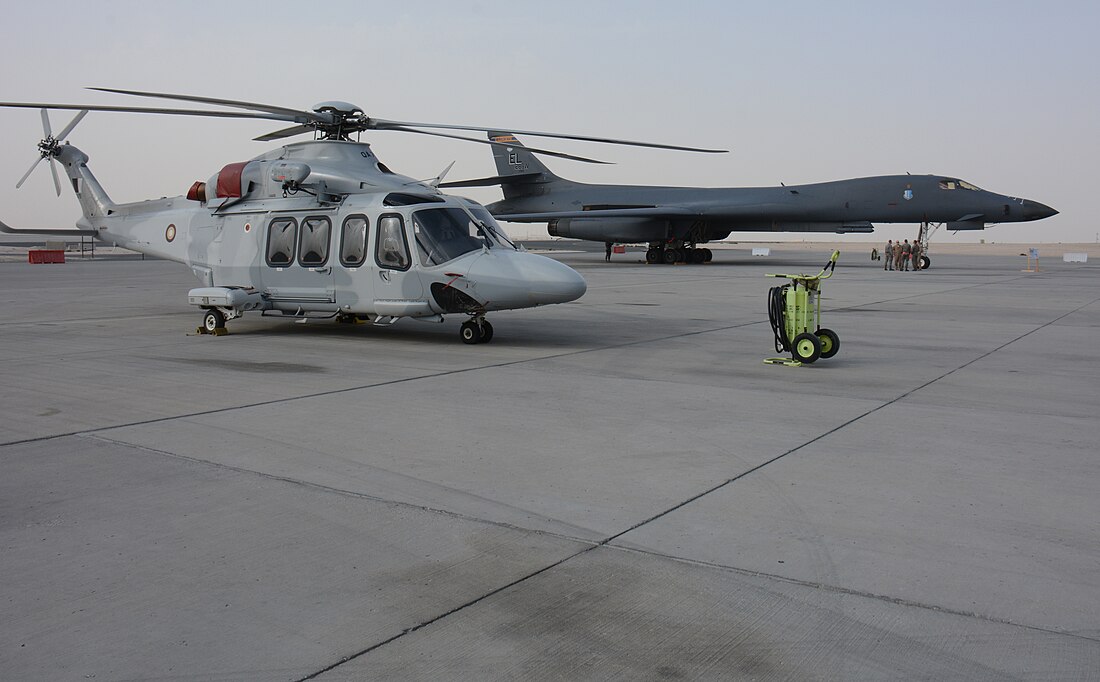Al Udeid Air Base
Military facility southwest of Doha, Qatar, used by US Air Force From Wikipedia, the free encyclopedia
Al Udeid Air Base (Arabic: قاعدة العديد الجوية) is one of two military bases southwest of Doha, Qatar, also known as Abu Nakhlah Airport (مطار أبو نخلة).
| Al-Udeid Air Base | |||||||||
|---|---|---|---|---|---|---|---|---|---|
قاعدة العديد الجوية | |||||||||
| Near Doha, Al Rayyan in Qatar | |||||||||
 A Qatar Emiri Air Force AW139 and a US Air Force B-1B Lancer on the flight-line at Al Udeid Air Base during 2016. | |||||||||
 Emblem of the Qatar Emiri Air Force | |||||||||
| Site information | |||||||||
| Type | Qatar Emiri Air Force base | ||||||||
| Owner | Qatar Armed Forces | ||||||||
| Operator | Qatar Emiri Air Force United States Air Force Royal Air Force | ||||||||
| Condition | Operational | ||||||||
| Location | |||||||||
| Coordinates | 25°07′07″N 051°19′07″E | ||||||||
| Site history | |||||||||
| Built | 1996 | ||||||||
| In use | 1996 – present | ||||||||
| Garrison information | |||||||||
| Garrison |
| ||||||||
| Airfield information | |||||||||
| Identifiers | IATA: XJD, ICAO: OTBH | ||||||||
| Elevation | 40 metres (131 ft) AMSL | ||||||||
| |||||||||
| Source: World Aero Data[1][2] and Google Maps[3] | |||||||||
It houses the Qatar Emiri Air Force, United States Air Force, Royal Air Force, and other foreign forces. It is host to a forward headquarters of United States Central Command, headquarters of the United States Air Forces Central Command, No. 83 Expeditionary Air Group RAF, and the 379th Air Expeditionary Wing of the USAF.
According to media reports in June 2017, the base hosted over 11,000 U.S. and U.S.-led anti-ISIL coalition forces and over 100 operational aircraft.[4]
It is the largest U.S. military base in the Middle East.[5]
History
Summarize
Perspective
United States Air Force
Following joint military operations during Operation Desert Storm in 1991, Qatar and the United States concluded a Defense Cooperation Agreement that has been subsequently expanded. In 1996, Qatar built Al Udeid Air Base at the cost of more than $1 billion. The U.S. first used the then-secret base in late September 2001, when the Air Force needed to get aircraft in position for its operations in Afghanistan. The U.S. has nearly 40,000 military personnel in the Middle East. The U.S. Fifth Fleet is in Bahrain and has 28,000 military personnel in Kuwait, Bahrain and Qatar. Kingdoms, including Qatar, cover 60 percent of the costs, around $650 million.[6]
The official acknowledgement of the base came in March 2002, when Vice President Dick Cheney stopped there during a trip to the region with a group of reporters. In April 2003, shortly after the start of the U.S.-led invasion of Iraq, the U.S. Combat Air Operations Center for the Middle East moved from Prince Sultan Air Base in Saudi Arabia to what was then a backup headquarters built a year prior in Qatar that was viewed as a more congenial location for basing U.S. troops.[7]

Al Udeid and other facilities in Qatar serve as logistics, command, and basing hubs for the U.S. Central Command (CENTCOM) area of operations, and oversees U.S. air operations in countries, including Iraq, Afghanistan, and Syria.[8]
Royal Air Force
Between 2004 and 2009 the airbase was used by the Royal Air Force with transport and fast-jet aircraft to support Operation Telic (Iraq War) and Operation Herrick (War in Afghanistan).[9]
These included 6 to 8 Tornado GR4 aircraft drawn from different parts of the Royal Air Force as well as multiple Vickers VC10 from the No. 101 Squadron RAF. British Tornados were equipped with a range of stores, including the Vicon Recce Pod, LITENING targeting pod, 1000 lb HE bombs, Paveway II and Paveway III laser-guided bombs, and the RAPTOR Recce Pod. They were chosen for their currency and up-to-date modification state.[10]
The RAF aircraft were accompanied by aircraft engineers and personnel active in support and operation management roles. Between 20 March to 15 April 2003, the Al Udeid Wing of the RAF flew 268 sorties in operations against the Government of Saddam Hussein in Iraq at the start of the Iraq War.[9]
Royal Australian Air Force
As part of Australia's contribution to coalition forces in the 2003 invasion of Iraq, fourteen F/A-18 Hornet fighters from No. 75 Squadron RAAF were based at Al Udeid, along with two P-3 Orion maritime patrol aircraft and three C-130 Hercules military transport aircraft. During the early phases of the war, the Hornets flew long missions escorting and protecting coalition AWACS Early warning aircraft and tanker aircraft used for air-to-air refueling. Later, when the threat to aircraft was reduced, the Hornets switched to the ground attack and combat support roles and were used to attack Iraqi ground forces with laser-guided bombs. The Orions flew long endurance missions over the Persian Gulf tracking vessels, curbing smuggling and guarding against the threat posed by suicide boats. The deployed Hercules flew supplies and equipment into Iraq, and later flew some of the first humanitarian aid into Baghdad. The fourteen Royal Australian Air Force Hornets flew over 670 sorties during the war, including 350 combat sorties over Iraq.[11]
Current use
Summarize
Perspective

Qatari Emiri Air Force
Al Udeid Air Base is the main headquarters for the Qatar Emiri Air Force, although some of its squadrons are based at Doha International Airport among others.[12]
Structure:[13]
- Al Zaeem Mohamed Bin Abdullah Al Attiyah Air College
- 6th Squadron with the Airbus Helicopters H125 and the AgustaWestland AW169
- 31 Squadron with the PAC MFI-395 Super Mushshak and the Pilatus PC-21
- ?? Squadron with the Pilatus PC-24
- Airlift Group
- 10th Transport Squadron with the Boeing C-17A Globemaster III
- 12th Transport Squadron with the Lockheed Martin C-130J-30 Super Hercules
- Flying Wing 3
- 20th Squadron with the AgustaWestland AW139
- 41 Squadron with the Boeing AH-64E Apache (QRA)
- International Flight Training School (IFTS)
- ?? Squadron with the Alenia Aermacchi M-346 Master
- Flying Wing 5
- 51 Squadron with the Boeing F-15QA Strike Eagle
- 52 Squadron with the F-15QA
- 53 Squadron with the F-15QA
Royal Air Force
After the withdrawal of British Tornados and VC10s in Summer 2009 to other locations, Royal Air Force activities at Al Udeid were reduced.[10]
Since 2014 it has been used as HQ for British involvement in airstrikes against ISIS in Iraq (Operation Shader).[14]
The Royal Air Force formally stationed an RC-135 Rivet Joint signals intelligence aircraft at the base to operate over Iraq and Syria, although this aircraft has been pictured operating from Chania International Airport in Crete.[15]
United States Air Force

Military cooperation and foreign assistance
With its small territory and narrow population base, Qatar relies to a large degree on external cooperation and support for its security. Qatar invested over US$1 billion to construct the Al Udeid airfield during the 1990s; it did not have a large air force of its own at the time. The United States Army Corps of Engineers also awarded over $100 million in Military Construction Air Force (MCAF) contracts for the construction of U.S. storage, housing, service, command, and communication facilities.[16]

In early June 2017, the Pentagon said that the diplomatic rupture and tensions between Qatar and some of its Arab neighbors would not affect U.S. operations at the Air Base.[17]
The base stationed F-22 Raptors for the first time in June 2019.[18] A month later, an expansion of the base was announced to be funded by Qatar,[19] which would cost $1.8 billion.[20]
Units
- United States Marine Corps (USMC) Marine Tactical Electronic Warfare 3 (VMAQ-3) 'Moondogs' from 17 February 2014, with Northrop Grumman EA-6B Prowlers[21] until 9 August 2014.[22]
Congress appropriations and authorizations
The National Defense Authorization Act for Fiscal Year 2008 (P.L. 110-181) authorized $81.7 million in FY2008 spending to build new Air Force and Special Operations facilities in Qatar.[23]
The National Defense Authorization Act for Fiscal Year 2009 (P.L. 110-417) authorized $69.6 million in FY2009 spending to build new Air Force and Special Operations facilities.[24]
The National Defense Authorization Act for Fiscal Year 2010 (P.L. 111-84) authorized $117 million in FY2010 spending to build new Air Force recreational, dormitory, and other facilities at Al Udeid.[25]
References
External links
Wikiwand - on
Seamless Wikipedia browsing. On steroids.

